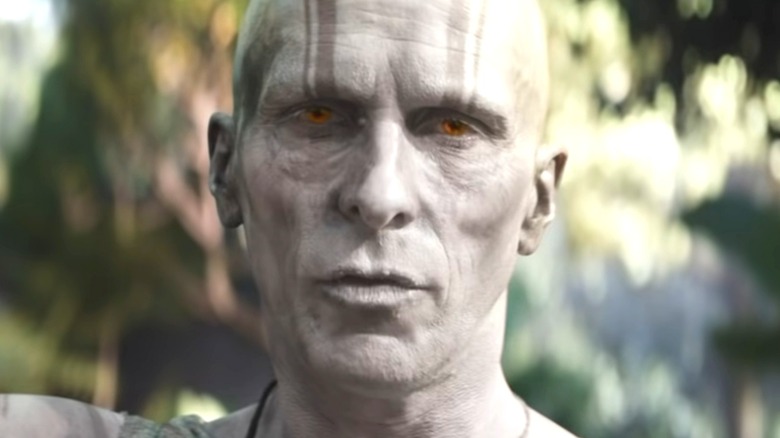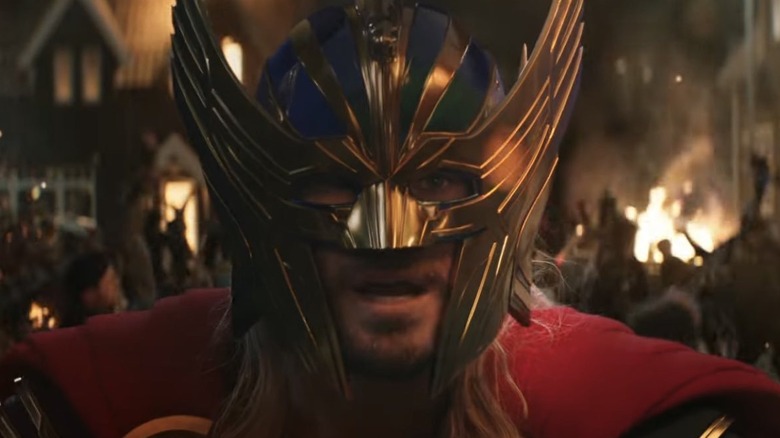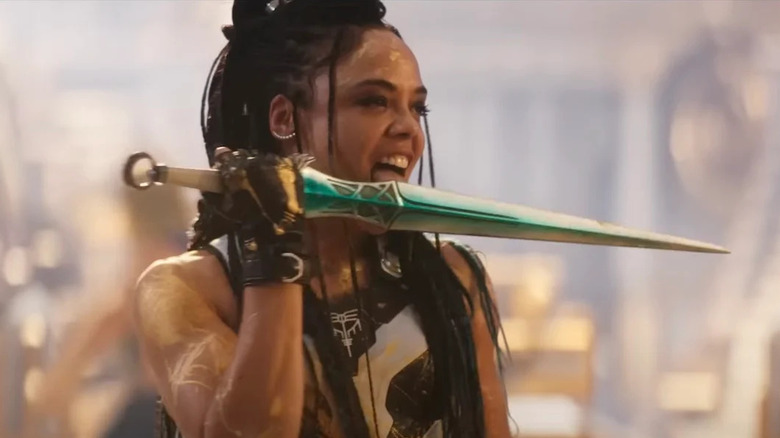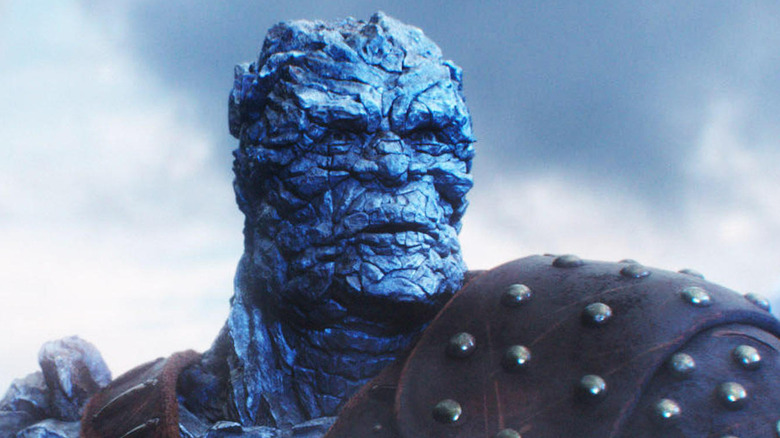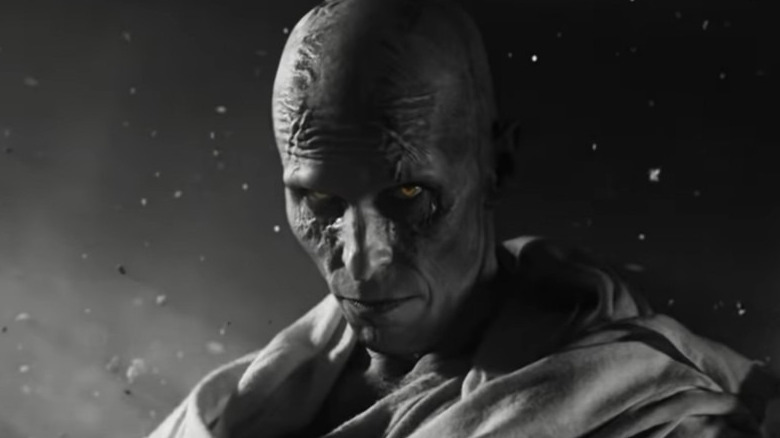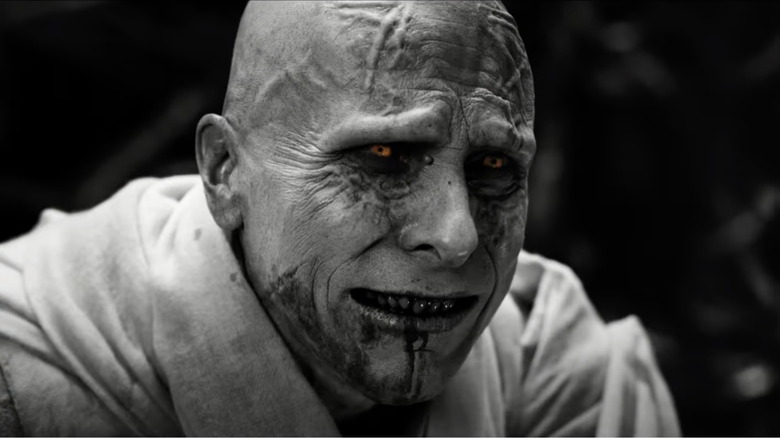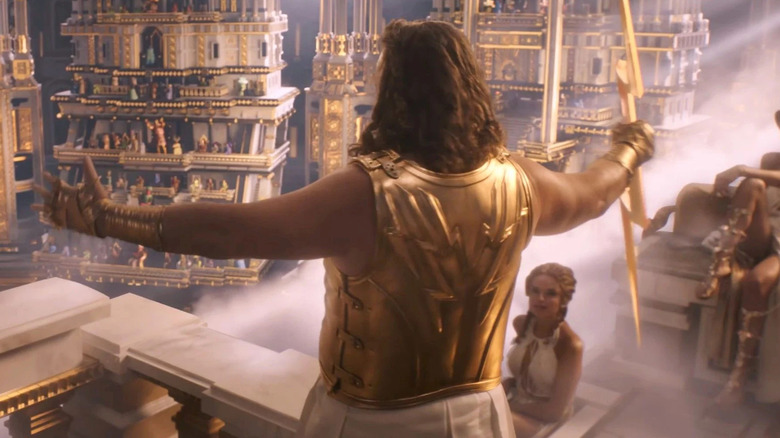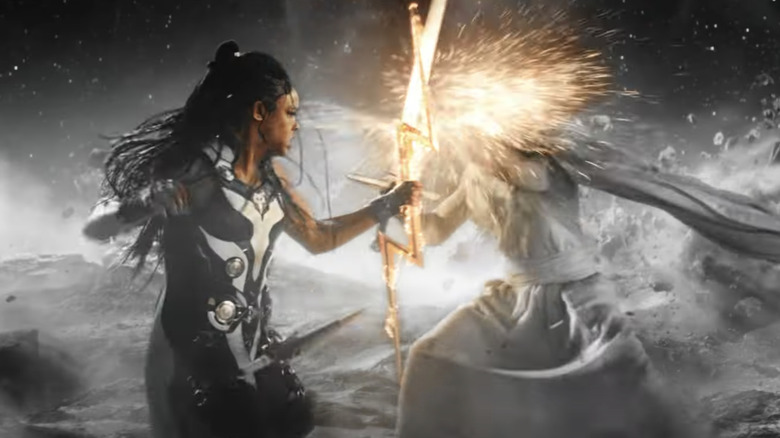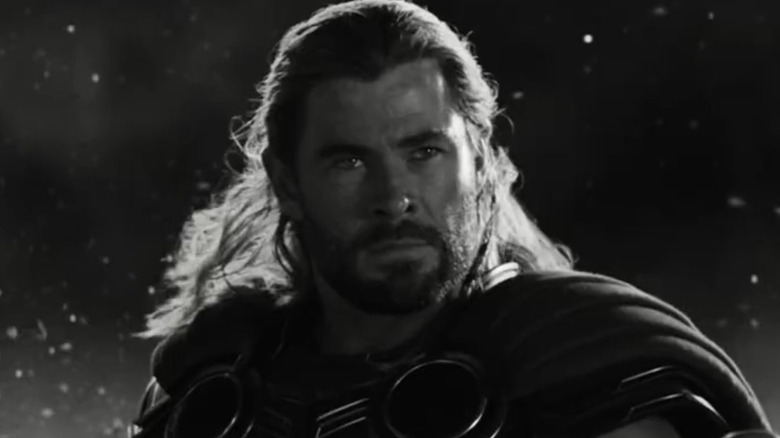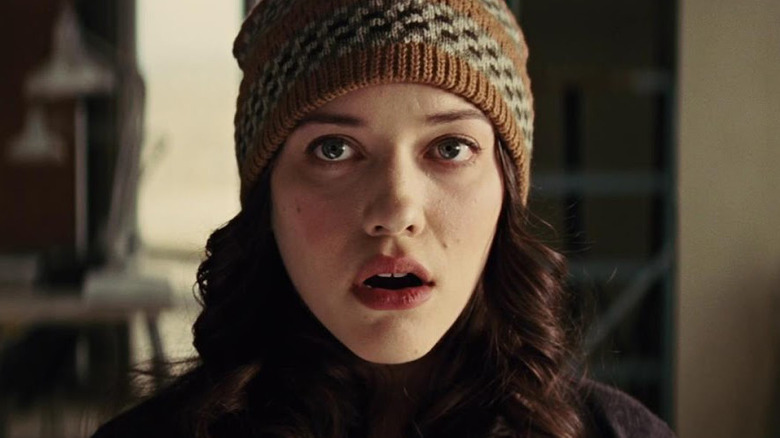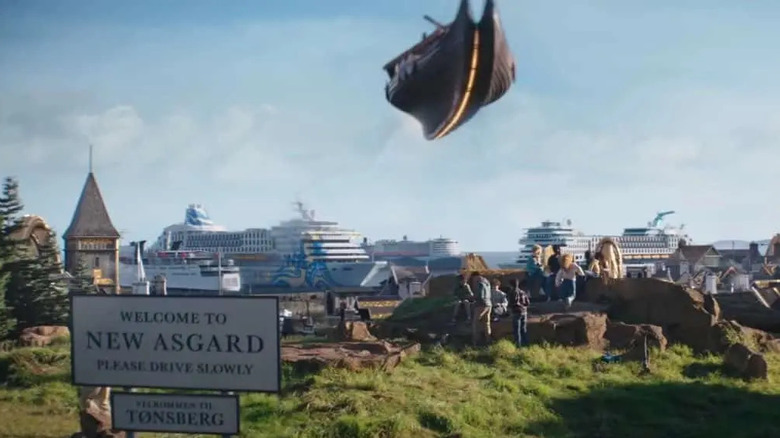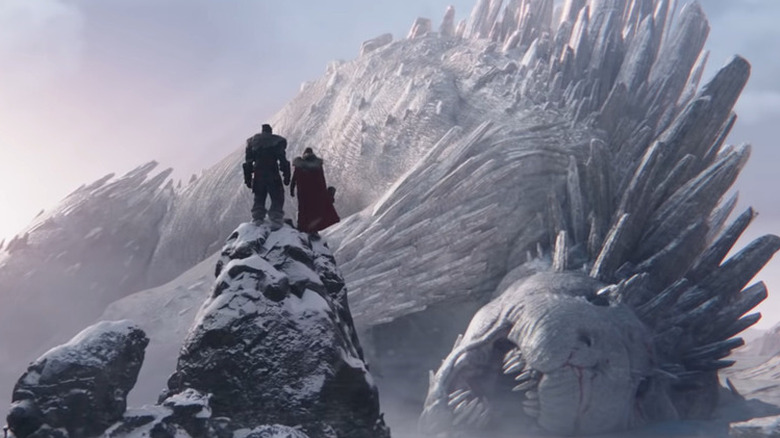6 Best And 6 Worst Things In Thor: Love And Thunder
Thor has been a foundational superhero in the Marvel universe for decades, having made his first appearance in 1962's "Journey Into Mystery" #83. He was even a canonical founding member of Marvel's equivalent to the Justice League, the Avengers. However, Thor's initial films were met with a tepid response. While a financial success, 2011's "Thor," directed by Kenneth Branagh, received, at best, mixed reviews. Meanwhile, Thor's sequel, 2013's "Thor: The Dark World," directed by Alan Taylor, found an even colder reception.
Luckily, eccentric New Zealand writer-director Taika Waititi took over the franchise for 2017's "Thor: Ragnarok." As evidenced by the '80s power metal cover-influenced aesthetics of that film, Waititi's mission was to make Thor fun, galactic, and goofy, in stark contrast to the self-serious Shakespearean take he had been given up until then.
This approach was a huge success -– both critically and financially -– so, naturally, Waititi has returned to co-write and direct the sequel to "Thor: Ragnarok" with the similarly colorful and rock-infused "Thor: Love and Thunder." So what are the best parts of the new "Thor" film — and what are the worst?
Best: Jane Foster as Mighty Thor
Despite Jane Foster initially being saddled with the cliché role of "superhero's powerless girlfriend" in the first "Thor" movie, actress Natalie Portman nonetheless was able to make the character stand out. In Portman's hands, Jane was smart, strong-willed, and able to build romantic chemistry with the hunky and godly Thor believably. In fact, it can be argued that their relationship is at the center of the first film –- where she's able to teach and humble Thor so that he can eventually be worthy of Mjolnir by the end.
Even "Thor: The Dark World," which is at or near the bottom of most ranked lists of MCU films, the relationship between Jane and Thor is still one of the only highlights — though the portal fight at the end is pretty fun too, we suppose.
However, Jane's return as the Mighty Thor in "Thor: Love and Thunder" is definitely one of the highlights of "Thor: Love and Thunder." Mighty Thor is charming, fun to watch, and her costume is amazing. Beyond that, her use of the formerly shattered Mjolnir is also really clever, as she uses the splinters as bullet-like projectiles to kill enemies.
Worst: Overuse of CGI
While there are indeed some really cool and inventive sequences in the film -– including an action sequence inside of a shadow realm -– there still is the fact that much of the CGI is over-abundant, as is the case in many MCU films.
It's not like the money isn't seen on screen or that the VFX artists are somehow untalented, either. Quite the contrary. The issue is that with the often firm and inflexible release dates from studios — as well as an increasing number of VFX shots needed to be completed for most big-budget films nowadays — there's going to be some shots that are given more care than others. There's only so much time animators, compositors, and renderers can provide to a CG shot before it has to be shipped to release, and the BBC reports that many visual artists are overworked.
As a result, while certain scenes in "Thor: Love and Thunder" are amazing and awe-inspiring, or are so realistic that people aren't even aware VFX is being utilized (because, again, VFX artists are talented, and CGI is a great tool for film), other shots look fake or shoddy.
Best: LGBTQA+ Representation
It is often troubling how little LGBTQA+ representation is shown in mainstream, tentpole films –- especially ones from Disney. While studios may fear reprisal from conservative organizations, that should nonetheless be secondary to increasing the visibility of already marginalized groups, especially in these unprecedented times.
Luckily, with "Thor: Love and Thunder" Taika Waititi has made multiple characters canonically -– and explicitly –- queer, rather than simply alluded to or implied, as in "Thor: Ragnarok." In fact, he and actress Tessa Thompson -– who plays the bisexual Asgardian warrior Valkyrie — talked about in interviews how disappointed they were that they had to cut a scene of her kissing a woman in the aforementioned "Thor: Ragnarok."
However, not only that, but Korg (voiced by Waititi) mentions having two dads and even has a romantic date with another male rock creature at the end of the film, holding hands to make a baby (since that's how his species reproduces). Furthermore, we see Thompson's Valkyrie flirting with women gods in the Omnipotence City, and later on, when talking with Korg, she says in dialogue that she's been having "girlfriend troubles." With those examples, it seems that Waititi has successfully made a queer MCU film.
Worst: Queer affection told, not shown
The fact that characters are explicitly queer in "Thor: Love and Thunder" is unambiguously a good thing, as more representation in bigger mainstream things is a huge step in the right direction. However, while these characters are explicitly LGTBQA+ in dialogue, they are still not explicitly shown as queer. Heck, even "Star Wars: The Rise of Skywalker" and "Lightyear" both featured an on-screen lesbian kiss! It's not like heterosexual kisses are similarly shunned –- Thor and Jane share more than one on-screen kiss in the film, for instance. It's a lot of "telling not showing" on the film's part when it comes to queer representation.
This is an issue, as it allows homophobic censors to easily re-dub the dialogue to erase the queer text, which is easier to do than editing out a quick scene. Furthermore, the lack of actual on-screen queer affection helps perpetuate alienation and marginalization among queer audiences that aren't shown a lot of representations of explicitly LGBTQA+ relationships –- especially in a mainstream context. If Thor and Jane can kiss, so can Valkyrie and a girlfriend, or Korg and his husband — come on!
Best: Christian Bale as Gorr the God Butcher
Christian Bale is no stranger to starring in popular comic book movies, having portrayed Batman in Christopher Nolan's "The Dark Knight" trilogy. He's also no stranger to playing villainous characters, such as the diabolical yuppie serial killer in 2000's "American Psycho," as well as former vice president Dick Cheney in 2018's "Vice." However, playing Gorr the God Butcher in Marvel's "Thor: Love and Thunder" is the first time he's done both at the same time.
Of course, he pulls it off with aplomb. He's helped by the fact that Gorr is a fascinating character with an instantly sympathetic motivation. With how things in the world have been going lately, who wouldn't want to butcher some lazy gods that just sat back and let it happen?
He's also given the unenviable task of making an evil-looking character that looks like Marilyn Manson and kidnaps children to be given a believable redemption arc, which he nails. The last scene with his reincarnated daughter, metaphorically forgiving the gods by allowing Thor to take care of her, is genuinely emotional.
Worst: Gorr's characterization is inconsistent
While Christian Bale should be rightly praised for his portrayal of Gorr the God Butcher, that is not to say that the character was particularly well-written. Bale certainly nails the big moments, such as his intro where he has to bury his daughter, his murder of the god he worshipped who mocked his suffering, and the reconciliation with Thor at the end. The issue is inconsistently writing, not how the character is performed.
For one thing, Gorr's plan to defeat Thor makes little sense ideologically. If he hates the gods because they're lazy and inattentive, why would he think Thor would care about the children he kidnapped? Also, why would he put the (mostly) Asgardian children in danger when his entire motivation is based on the fact gods failed to protect his daughter? He talks about how he's not a hypocrite, but then we see that during the battle with Thor there are multiple times where falling statues could've killed the kids if Thor wasn't there to protect them. How is that not hypocritical?
If the argument is that the Necrosword is making him insane, thus his motivation doesn't have to make sense, that's just a cop-out. Even if it's true, it's still not interesting. Neither is Gorr being evil for evil's sake –- which doesn't seem to be the film's intention –- especially with the great ending scene that wants the audience to feel sympathy for him. A sympathetic villain with clear motivations is generally more intriguing than one who doesn't, and frankly, without Bale's charisma pulling it through, there's a good chance Gorr wouldn't have worked nearly as well.
Best: Omnipotence City
Omnipotence City, the literal "city of the gods" featured in "Thor: Love and Thunder," is a sight to behold. The city is mostly depicted using CGI, in one of those sequences the VFX artists seem to have put the most work into. Even better, the many omnipotent gods in the background were also largely created by using elaborate make-up and prosthetics — as well as a few puppets.
Furthermore, there are a ton of Easter eggs that are a feast for the eyes in this sequence, such as an anime-inspired god in the shape of a cute, cartoony, anthropomorphic bao bun. The many disparate deities from various ancient traditions and religions (including a veiled reference to Jesus, i.e. "the carpenter god") are really impressive — not just for their intricate designs — but for the sheer number of them shown on screen at one time.
Of course, the real main course is Russell Crowe as a comically flamboyant Zeus sporting an exaggerated Greek accent. He's certainly fun and zany, but he's also believably dangerous when he attacks Thor and his friends.
Worst: Sidelining Valkyrie
Valkyrie, as played by Tessa Thompson, has been a highlight in the MCU since her debut in 2017's "Thor: Ragnarok." She's strong and has great comedic timing when the time calls for it. Beyond that, Valkyrie as a character also has a real pathos and tragedy about her (due to the death of her comrades at the hands of Hela) that Thompson is able to call on in "Thor: Love and Thunder."
While it makes sense to have the final battle in a superhero film end with a one-on-one clash between the story's hero and villain, it's still disappointing how the movie writes Valkyrie out of the final fight scene to make that possible. It doesn't kill her off, thankfully, but it does the next worst thing by completely sidelining her.
True, Jane Foster comes in at the last minute to save Thor and deal the final blow to Gorr's Necrosword, but that makes Valkyrie's absence even more egregious. Couldn't she have at least helped lead the kids to safety while Jane and Thor fought? Even if Waititi wanted to focus the last sequence on the two Thors, it makes Valkyrie look weaker by not being willing to fight when she is simply injured, while Jane is ready to fight when death from her cancer is a real possibility.
Best: Shadow Realm
One of the most visually-striking sequences in "Thor: Love and Thunder" occurs in the Shadow Realm where Gorr the God Butcher resides. It is a place where everything is in stark black-and-white, evoking the immense contrast found in Robert Rodriguez's graphic novel adaptation "Sin City." Beyond that, whenever our heroes attack Gorr with their energy powers from Stormbringer, Mjolnir, or Zeus' lightning bolt, it lights up only where the attacks reflect, giving the action sequence a unique aesthetic flair. Finally, Gorr's evil eyes are a glowing yellow among the stark surroundings.
It's a cool visual idea, executed brilliantly. It is explained in the film that light refuses to pass in the Shadow Realm, which is admittedly a hard thing to communicate in a visual medium, as pitch-black doesn't really allow for exciting action sequences. Waititi went a little impressionistic with his approach, but it was absolutely the right choice.
Worst: Not enough Darcy
Kat Dennings as Jane Foster's bubbly and eccentric — though still brilliant — assistant Darcy Lewis, has been a highlight of all the solo Thor films (and even "WandaVision" when she eventually showed up there). Dennings has amazing charisma and comedic timing, with her delivering some of the only truly comedic lines in "Thor: The Dark World," such as mispronouncing Mjolnir as "moo-moo."
Furthermore, she has great chemistry with Natalie Portman's Foster, as they seem to share a real bond that only grows with each subsequent film. As such, it's a shame she has so little to do in "Thor: Love and Thunder," their third collaboration together.
To be fair, Darcy and Jane's scene in the hospital — as the audience first learns about Foster's cancer diagnosis — is a highlight for sure. While an obviously sad scene, there's a warmth to their interactions that keeps it from becoming maudlin or melodramatic. Instead, it comes across as achingly human.
It's just disappointing there was no other scene with them interacting in the rest of the film. Maybe Dennings can return for a "Thor" sequel. There's always hope, though, right?
Best: New Asgard tourist attraction
One of the most clever and fun plot points in "Thor: God and Thunder" was the fact that New Asgard, located in Norway on Earth and last seen in "Thor: Ragnarok" and "Avengers: Endgame," is now a gaudy tourist attraction. It evokes strongly how the majesty of New Zealand was turned into an entire tourist industry hawking "The Lord of the Rings" franchise. This reading also makes sense because Waititi is a fellow New Zealander like "The Lord of the Rings" director Peter Jackson and probably has some strong feelings about the overt commercialization of his nation.
The sight gags are also amazing and hilarious as well. There are flying Asgardian Viking ships that tourists can ride on, complete with the kind of safety harnesses you'd see on roller coasters. Guests are treated to a cheesy play about Thor's adventures, with a returning Matt Damon, Sam Neill, and Liam Hemsworth as fake Loki, fake Odin, and fake Thor, respectively, as well as Melissa McCarthy as a scene-chewing fake Hela. Valkyrie is even seen being bombarded by marketers to help sell Asgard as a tourist destination. In fact, her intro is literally blatant product placement –- but it works in this context.
Furthermore, Jane finds access to Mjolnir simply because it's on display during a tour. Everything thus has become commercialized in a very humorous (if cynical) way.
Worst: Not enough on-screen god killing
Listen, when you think of a villain who calls himself Gorr the God Butcher, you expect to see a lot of god butchering, correct? Imagine the amazing action sequences that could exist, such as Gorr climbing up giant gods like Wander from the game "Shadow of the Colossus," or him engaging in well-choreographed fight scenes against powerful humanoid god-beings.
The issue is that the gods are only killed off-screen, save the opening sequence where Gorr acquires the Necrosword for the first time. In fact, the only real consequence we see of Gorr's actions -– outside of Thor hearing about it -– is when Thor and Korg come across the corpse of Falligar the Behemoth, one of the best details from the first trailer.
To be fair, the film has a lot of ground to cover, so it makes sense to focus and tighten the plot. However, to be less fair, the film is only two hours, and it's hard to take Gorr's threats seriously when we don't actually see him succeeding outside of what amounts to a sucker punch. In fact, he loses the first fight with Thor in New Asgard. He succeeds in stealing the children, but that plan doesn't make much sense to begin with, given the character's motivations.
The film also has a lot of narrative detours, so perhaps showing Gorr inventively killing gods (even if only in a montage) would make his threat seem more immense and pressing, as well as further focus the story if other plot threads were culled. Finally, maybe do a different plot than having Thor save a group of precocious kids? Just a thought.
